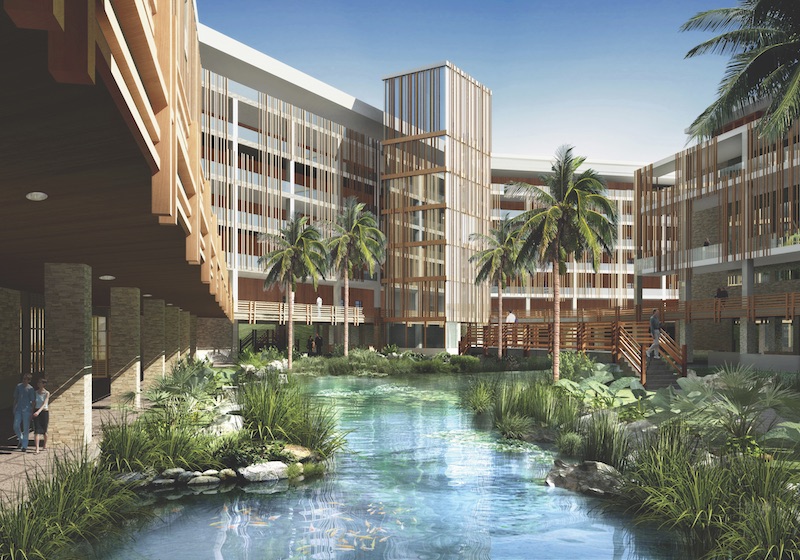The term wellness has been kicked around a lot in healthcare design circles lately. But what precisely do we mean by wellness? And, assuming wellness is a good thing, how can designers create healthcare facilities that enhance wellness?
Responses to those questions are embedded in a rigorous case study on “salutogenesis”—“the origin of health,” a term developed by Israeli American medical sociologist Aaron Antonovsky in his 1979 book, Health, Stress and Coping.
Three healthcare designers at GBBN Architects, Cincinnati—Angela Mazzi, AIA, ACHA, EDAC; Marcene Kinney, AIA, LEED AP; and Jon Hofmann, AIA, LEED AP—wondered why healthcare environments are seen as places where the experience of treatment is worse than the disease. Instead of being a place of dread, they wanted to know: Could a hospital provide a therapeutic environment that is “truly immersive, encouraging a patient to feel at ease and be engaged?” If so, would that promote wellness?
To test this hypothesis, the team studied one of GBBN’s own projects, The Sanya Fuwai Center. Situated on 15 acres in the mountains of the tropical island of Hainan, in China, it is more like a resort than a hospital. It provides complete inpatient and outpatient care, along with complementary therapies in a spa and hotel to allow for “relaxing, resetting, and recharging.”
Their report, “A Healthy State of Mind: Psychosocial Triggers to Wellness,” explores “psychosocial behavior cues” that provide an antidote to the anxiety and isolation that patients experience in most healthcare settings. They discuss four “salutogenic design drivers”—prospect and refuge, sense of coherence, relaxation response, and the science of happiness (who knew?)—and discuss their impact on five types of spaces: quiet, communal, casual, interactive, and season.
The GBBN researchers found several factors contribute to a psychological state that is receptive to healing:
• Incorporating elements that visually reference familiar positive environments, such as retail, residential, and recreational spaces. Provision should be made for walking paths, work areas, areas of contemplation, and destination points.
• Allowing choice and control in how the environment can be used and manipulated, through the provision of movable furniture, “personalization areas,” and variety in the types of spaces.
• Reinforcing the level of socialization appropriate to the activity within the environment through the use of proxemics—how much space people feel it necessary to set between themselves and others.
• Connection to nature for wayfinding and as a focal point within a space. Access to natural light is another key dimension of nature.
Download the 28-page paper at http://bit.ly/29SNsqA.

Read about more innovations from BD+C's 2016 Great Solutions Report
Related Stories
Giants 400 | Feb 9, 2023
New Giants 400 download: Get the complete at-a-glance 2022 Giants 400 rankings in Excel
See how your architecture, engineering, or construction firm stacks up against the nation's AEC Giants. For more than 45 years, the editors of Building Design+Construction have surveyed the largest AEC firms in the U.S./Canada to create the annual Giants 400 report. This year, a record 519 firms participated in the Giants 400 report. The final report includes 137 rankings across 25 building sectors and specialty categories.
Giants 400 | Feb 6, 2023
2022 Reconstruction Sector Giants: Top architecture, engineering, and construction firms in the U.S. building reconstruction and renovation sector
Gensler, Stantec, IPS, Alfa Tech, STO Building Group, and Turner Construction top BD+C's rankings of the nation's largest reconstruction sector architecture, engineering, and construction firms, as reported in the 2022 Giants 400 Report.
Healthcare Facilities | Jan 31, 2023
How to solve humidity issues in hospitals and healthcare facilities
Humidity control is one of the top mechanical issues healthcare clients face. SSR's Lee Nordholm, PE, LEED AP, offers tips for handling humidity issues in hospitals and healthcare facilities.
Augmented Reality | Jan 27, 2023
Enhancing our M.O.O.D. through augmented reality therapy rooms
Perkins Eastman’s M.O.O.D. Space aims to make mental healthcare more accessible—and mental health more achievable.
Hospital Design Trends | Jan 19, 2023
Maximizing access for everyone: A closer look at universal design in healthcare facilities
Maria Sanchez, Interior Designer at Gresham Smith, shares how universal design bolsters empathy and equity in healthcare facilities.
Fire and Life Safety | Jan 9, 2023
Why lithium-ion batteries pose fire safety concerns for buildings
Lithium-ion batteries have become the dominant technology in phones, laptops, scooters, electric bikes, electric vehicles, and large-scale battery energy storage facilities. Here’s what you need to know about the fire safety concerns they pose for building owners and occupants.
Healthcare Facilities | Dec 20, 2022
4 triage design innovations for shorter wait times
Perkins and Will shares a nurse's insights on triage design, and how to help emergency departments make the most of their resources.
Healthcare Facilities | Dec 20, 2022
Designing for a first-in-the-world proton therapy cancer treatment system
Gresham Smith begins designing four proton therapy vaults for a Flint, Mich., medical center.
Cladding and Facade Systems | Dec 20, 2022
Acoustic design considerations at the building envelope
Acentech's Ben Markham identifies the primary concerns with acoustic performance at the building envelope and offers proven solutions for mitigating acoustic issues.
Sponsored | Resiliency | Dec 14, 2022
Flood protection: What building owners need to know to protect their properties
This course from Walter P Moore examines numerous flood protection approaches and building owner needs before delving into the flood protection process. Determining the flood resilience of a property can provide a good understanding of risk associated costs.
















